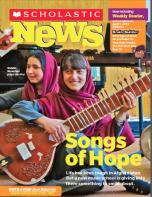Omar Sarwari, a 12-year-old Afghan boy, flew to the U.S. in February 2013 along with 48 other students to perform music in three American cities. He couldn’t wait to do three things: play his clarinet, eat pizza and see the White House.
Omar attended ANIM (Afghanistan National Institute of Music), a music school for disadvantaged youth, both girls and boys in Kabul. Many of the students are orphans and some, before coming to ANIM, sold plastic bags and chewing gum on the street before enrolling in ANIM. The school was founded by Ahmad Sarmast, a native of Afghanistan and son of the well-known Afghan composer Ustad Salim Sarmast.
“We are sick and tired of war,” Ahmad Sarmast said. “Music can bring us closer together.” Music had been a well-established art in Kabul, once known as the Paris of the East, but it was banned throughout the country by the government in 1992. The ban officially ended in 2001; still music has yet to regain its popularity.
Students at ANIM study ancient string instruments their relatives may have played, such as the rubab, sitar and sarod, or a drum called a tabla. Others choose less familiar instruments like the trumpet or violin because they like the sound and they want to try something new. (In addition to the clarinet and music theory, Omar studies English, Arabic, Dari, Pashto, Islam, math, physics, history and geography.)
Gulalai Norestani was living in an orphanage when she first heard of ANIM. “I raised my hand and said I wanted to go,” she explained. She likes the music school so much that she wants other girls to have the same opportunity she has. “Some people are opposed to girls learning music. When I grow up I want to be a music teacher for girls,” she said.
At first Gulalai did not receive her uncle’s permission to participate in the U.S. tour. “My uncle at the beginning was against it,” she said. He worried about what his friends and neighbors would think. “I cried a lot,” Gulalai said. Her uncle hated to see her in tears. After several days he changed his mind and allowed her to go on the ANIM tour. “I was very, very happy,” Gulalai said.
The ANIM students rehearsed with the Maryland Classic Youth Orchestra at the Kennedy Center in Washington, DC, where they were treated to cracker jacks, root beer, pizza and cupcakes. They joked, taught each other phrases and compared money. “We need more of this in the world,” one of the Americans said. “Music is a language we all understand. It means peace.”
The next evening they performed in the grand concert hall to a spellbound audience. They played traditional Afghan songs as well as Vivaldi’s “Four Seasons” in a new energetic arrangement that combined Afghan rhythms.
And later that week? On to concerts at Carnegie Hall and New England Conservatory.
I was reminded of these young people this past week when I heard journalist Mellissa Fung speak at the Pulitzer Center.
Six years ago, Melissa was kidnapped in Afghanistan and held in a hole for twenty-eight days. When she was released she returned to Canada where she wrote about veterans from the war, many of them suffering from PTSD, brain injuries, and amputations. Mellissa remained haunted by the desire to return to Afghanistan and tell the story she never got to tell, the story of education for girls. http://pulitzercenter.org/reporting/asia-afghanistan-conflict-peacekeepi...
In May 2013, Mellissa traveled to Kabul with the Canadian Women for Women in Afghanistan, an NGO that supports education for girls. She said she didn’t want to remember Afghanistan as a place where something bad had happened to her. She wanted “to turn the spotlight back on the Afghans” and look for signs of progress.
She found what she was looking for not only in the stories of young girls she met but also in the data:
In 2001, fewer than 1 million students attended school. That number is now 10.5 million and 40 percent of the students are girls.
